What to Look for in a Ventilation Solutions Partner
How the right ventilation partner can provide compliant solutions for residential dwellings on time and within budget
TABLE OF CONTENTS
What to Look for in a Ventilation Solutions Partner
Introduction
Ventilation isn’t just about moving air—it’s about safeguarding health, comfort, and well-being.
For property developers and contractors, it’s an unseen force impacting how buildings perform and how people live within them. But delivering effective ventilation isn’t easy. As regulators attempt to make buildings more airtight and energy-efficient, the stakes for getting it right have never been higher. Choosing the right ventilation solutions partner isn’t just a technical decision—it’s key to compliant and cost-effective project outcomes.
A specialist ventilation manufacturer brings clarity to complexity. Offering the expertise needed to navigate the challenges of today’s regulatory landscape, they don’t just supply products—they provide tailored solutions that align with your project requirements and goals. From ensuring systems meet performance targets to offering practical, cost-saving advice, they’re with you every step of the way.
With the right ventilation partner, you’ll achieve healthier indoor environments, meet even the most demanding regulations, and simplify processes in large-scale developments. In this guide, we’ll show you how to identify a partner who can do just that—bringing expertise, reliability, and value to your next project.
The importance of adequate ventilation for quality of life
In today’s increasingly sealed UK homes, built to enhance energy efficiency, the air we breathe indoors can become more polluted than the air outside. This is because airtight designs trap harmful pollutants like carbon dioxide (CO2), volatile organic compounds (VOCs), and moisture, leading to issues like mould growth, allergies, and even respiratory illnesses .
Poor indoor air quality (IAQ) has become a national concern. Studies from the Royal College of Physicians highlight that it contributes to thousands of premature deaths annually and burdens the NHS with significant costs. During the COVID-19 pandemic, when we spent up to 98% of our time indoors, the importance of good IAQ became impossible to ignore .
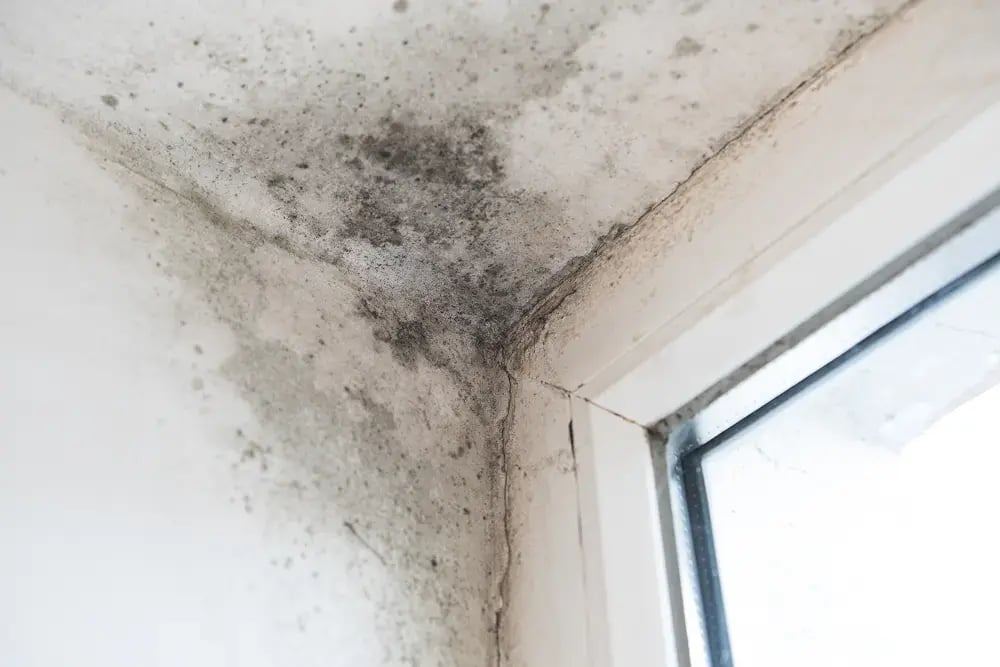
Ventilation systems offer an ideal solution, particularly Mechanical Ventilation with Heat Recovery (MVHR) solutions. Not only do they provide a constant supply of fresh, filtered air, but they also regulate temperature and recover heat from outgoing air—saving energy and ensuring year-round comfort. Investing in adequate ventilation isn’t just a choice; it’s essential for creating healthier, more liveable spaces .

Regulatory considerations
Navigating the complex web of UK Building Regulations can be daunting, but it’s crucial for compliance and achieving successful project outcomes. The key regulations to know include:
Approved Document O
(Overheating):
Offers guidance on keeping homes cool, especially in increasingly airtight buildings.
Approved Document L
(Conservation of Fuel & Power):
Ensures energy-efficient and sustainable designs.
Approved Document B
(Fire Safety):
Focuses on maintaining fire safety without compromising ventilation performance.
Add to that the NHBC Standards, which dictate best practices for new-build homes, and it’s clear that compliance isn’t just a box to tick—it’s an integral part of delivering safe, efficient, and high-quality multi-dwelling units.
However, regulation can complicate project planning, making it more important than ever to partner with a ventilation expert who understands the evolving landscape and maintains current knowledge. Together, you’ll create future-proofed environments that are not just compliant but healthier and more comfortable for the people who live in them.


A trusted solutions partner can help you meet these requirements head-on. With expertise in compliance, product design, and installation, the right partner will ensure your projects stay on track, on budget, and in line with the latest standards.
Key qualities to look for in a ventilation partner
From initial design stages to final handover and beyond, the success of your build project depends on having the right people by your side. A good ventilation solution partner should be able to support you at key stages of the RIBA Plan of Work process, particularly stages 2 through 6, providing expertise that ensures optimised performance and smooth delivery.
![]()
Stage 2: Concept Design
|
|
Stage 3: Spacial Coordination
|
|
Stage 4: Technical Design
|
|
Stage 5: Manufacturing & Construction
|
|
Stage 6: Handover
|
End-to-end solutions
End-to-end ventilation solutions go beyond supplying a cohesive range of high-quality products. It includes a suite of value-added services designed to enhance efficiency, reduce costs, and simplify project management at every stage.
An end-to-end solutions partner is more than just a supplier—they’re a collaborator who integrates seamlessly into your project workflow. With expert technical design advice, they can help optimise ventilation strategies to fit your unique requirements, even suggesting amendments that reduce costs without compromising performance. For example, they might recommend alternative ducting layouts or product selections to maximise energy efficiency and space utilisation.
During the specification phase of your project, they should bring in-depth knowledge of regulatory requirements and product capabilities to ensure your ventilation system is fully compliant and aligned with the project’s goals. If ventilation hasn’t been fully scoped at the design stage, they can step in to provide strategic guidance, giving you the confidence to move forward without delays.
The benefits of an end-to-end solutions partner extend well into the construction phase. A dependable partner offers on-site support, assisting your team with installation, troubleshooting, and real-time adjustments to keep the project on schedule. When it’s time for handover, they provide commissioning training, equipping your people with the skills to manage and maintain the system effectively.
This holistic approach simplifies project management by streamlining communication. Whether addressing technical queries during bidding or providing aftercare for installed systems, an end-to-end partner ensures that every detail is handled with precision.
Additionally, having a partner who can support bidding processes is invaluable. Their ability to offer clear, accurate specifications and regulatory assurances strengthens your proposals, increasing your chances of winning competitive tenders.
Single point of communication
In any construction project, juggling timelines, installations, and last-minute challenges can feel impossible without clear and consistent communication. That’s where a ventilation partner offering a single point of communication becomes invaluable.
Imagine having one dedicated expert by your side, guiding you through every stage, smoothing out complexities, and ensuring nothing falls through the cracks. With a centralised contact, you have a go-to person who knows your project inside and out. They coordinate schedules, resolve issues, and ensure the right support is always available.
Whether it’s an unexpected query during design, installation advice on-site, or final commissioning tweaks, you won’t be stuck chasing multiple teams for answers. Instead, your account manager ensures every detail is handled efficiently and precisely, keeping your project moving forward without delays.
But the benefits don’t stop there. A skilled account manager can tap into the wider expertise within their organisation to meet your needs. Need compliance advice? They’ll bring in the right regulatory specialist. Facing technical challenges? They’ll loop in a design expert. Their ability to enlist the right people at the right time streamlines the process, saving you from the back-and-forth of dealing with separate departments or third-party consultants.

Having one person accountable for coordinating your ventilation needs eliminates unnecessary friction, reduces miscommunications, and maintains focus on the bigger picture. The result? Fewer headaches, smoother timelines, and confidence that your project is in expert hands.
Tested and certified products
When it comes to ventilation systems, quality and reliability are non-negotiables. Partnering with a manufacturer whose products are both internally and independently tested and certified ensures your project not only complies with stringent UK standards but also performs to the highest expectations.
Independently tested products bring an added layer of assurance. They’ve undergone rigorous evaluations to confirm their efficiency, safety, and suitability for real-world applications. The best partners, however, take testing one step further by performing individual product testing instead of batch testing. This approach ensures that every unit leaving the factory meets exacting performance and electrical standards, eliminating the risk of variability or hidden defects.
Working with certified systems helps you avoid costly delays or compliance issues, making project delivery smoother and more predictable. And with individually tested products, you can trust that what you install will perform exactly as promised, offering reliability and peace of mind.
 What to look for:
What to look for:Choose a partner that provides systems that are compliant with SAP, ISO 9001, and other relevant standards. Products like MVHR units should also come with efficiency ratings and proven durability. Quality products not only guarantee performance but also minimise maintenance costs and downtime in the long term.
Clear, high-quality design documentation
For development consultants and contractors, time is money, and streamlined processes can make the difference between a smooth project and a chaotic one. That’s why the best ventilation partners provide clear, high-quality design documentation that simplifies workflows and integrates seamlessly into your design processes. With well-structured technical information readily available, you can confidently reuse and adapt solutions across projects, saving time and effort while maintaining dependable consistency.
The value of high-quality design documentation extends beyond the design phase. These documents should be easily interpretable, enabling all stakeholders to understand and apply them effectively. Detailed yet accessible schematics, performance data, test certificates, and installation guidelines ensure that everyone involved is working from the same playbook, reducing confusion and enabling collaboration across teams.
Clarity in design documentation also translates to more efficient installations. Misunderstandings during implementation can lead to costly errors, delays, and rework. By providing precise, comprehensive instructions, a reliable ventilation partner minimises these risks, helping to keep your project on time and within budget. Moreover, clear documentation makes it easier to achieve regulatory approvals, as inspectors can quickly verify that your ventilation systems meet all necessary standards—making compliance a breeze.
 What to look for:
What to look for:When selecting a ventilation partner, look for one who understands the importance of documentation that supports every stage of your project—from design and installation to handover. With clear, professional resources readily available, they’ll be able to help you work efficiently and build trust with your stakeholders, knowing that every detail has been accounted for.
Design services
A strong ventilation partner adds value to your project through robust design and technical expertise. They don’t simply supply products but actively review technical designs and provide informed recommendations.
This approach ensures that the product specification perfectly aligns with performance criteria, such as airflow rates, energy efficiency, and indoor air quality targets while staying within budget. Their expertise helps avoid overengineering or underperformance, striking the right balance between cost and capability.
Their role becomes even more critical for projects with high-density or complex layouts, such as multi-dwelling units or mixed-use developments. They can optimise ventilation layouts, recommend ducting routes and system configurations that maximise efficiency, and minimise installation challenges. This is particularly valuable when integrating multiple systems into a single building design.
 What to look for:
What to look for:Look for a company that offers support during the design phase, such as product selection guidance and integration advice to optimise IAQ and energy performance. Their input should result in systems that fit seamlessly into your overall design, from spatial coordination to technical compliance, reducing the risk of costly design changes later and ensuring efficient project execution.
Structured delivery
Organised and efficient delivery is as critical as the products themselves in fast-paced construction environments. For areas such as London, where space constraints, heavy traffic, and strict health and safety regulations can complicate logistics, a ventilation partner that takes a structured delivery approach can make all the difference.
With structured delivery, you not only gain a logistical advantage but also improve site organisation and efficiency—eliminating last-minute delivery concerns, even for the most demanding projects.
Partners like Titon take this a step further by offering floor-by-floor delivery. Instead of delivering bulk materials all at once, which creates clutter and confusion, they provide self-contained packages for each floor. This ensures that the right ventilation components are delivered precisely where they’re needed, when they’re needed, avoiding the hassle of sorting through duplicate parts or hunting for misplaced items and wasting time.
 What to look for:
What to look for:A reliable partner understands the specific challenges related to delivery and logistics and works proactively to meet stringent delivery requirements. From coordinating with your on-site teams to adhering to local safety regulations, the right partner will ensure your products arrive on time and meet all the necessary delivery standards.
Commissioning support
Proper commissioning is key for installing ventilation solutions that are fully optimised, compliant, and ready to deliver peak performance from day one. From adjusting airflow rates to fine-tuning controls, a partner that provides commissioning support ensures your system operates as designed. It also offers troubleshooting and maintenance guidance, following best practices to help you address minor issues upfront to avoid costly long-term complications.
Crucially, a good partner goes beyond technical setup to provide hands-on training and guidance. They ensure your team understands the system’s operation and maintenance through clear, practical instruction. This training fast-tracks implementation and gives you confidence that the system is set up for optimal performance.
Another critical aspect of commissioning support is on-site coordination. By coming in while building is underway, a strong partner can liaise directly with contractors, creating seamless integration with other building services and activities. Whether it’s balancing and performance testing or troubleshooting installation challenges, their on-site presence helps the project move forward as planned, avoiding delays or miscommunication between teams.
 What to look for:
What to look for:A proactive ventilation partner doesn’t just deliver the product and walk away—they provide hands-on assistance during the initial setup with value-adding commissioning support that equips your teams to set up systems that meet performance standards and regulatory requirements from the start.
Warranties and guarantees
When selecting a ventilation partner, comprehensive warranties and guarantees should be a given. At a minimum, the industry standard typically offers a 2-year guarantee, providing baseline protection against defects or faults. However, the best partners go further, offering extended warranties that demonstrate their confidence in their products and provide you with extra peace of mind.
A strong warranty safeguards your investment and reflects the reliability and quality of the systems you’re installing. Knowing that your ventilation partner stands firmly behind their products means fewer worries about unexpected maintenance costs or system failures down the line.
 What to look for:
What to look for:For added value, look for a partner who offers flexible extended warranties. This ensures long-term security, making meeting ongoing operational and compliance needs easier. By partnering with a provider with robust warranties and guarantees, you’re not just protecting your project but investing in trust and reliability that will last well beyond installation.
End user information
The effectiveness of any ventilation system doesn’t end with installation—it depends on how well it’s maintained and operated over its lifetime. This makes end-user information, such as comprehensive user manuals and clear instructions, vital to long-term performance and optimal indoor air quality.
These documents equip facilities teams, aftercare departments, and individual occupants with the knowledge to use and maintain their ventilation systems effectively. This includes straightforward guidance on tasks like filter replacements, servicing schedules, and troubleshooting, along with a transparent breakdown of associated maintenance costs.
A good ventilation partner doesn’t just provide generic manuals—they deliver tailored resources that meet the specific needs of your project. For example, bespoke documents can include detailed diagrams of the installed system, building-specific instructions, and maintenance recommendations that align with the property’s usage patterns. This level of detail gives professional maintenance teams and individual users everything they need to keep systems operating efficiently.
 What to look for:
What to look for:The right ventilation partner provides aftercare departments with product usage and technical materials, supporting optimal product performance beyond project completion. For individual occupants, they provide easy-to-understand guides to reduce the likelihood of misuse or neglect, which can compromise air quality or shorten the system’s lifespan.

System maintenance
Ventilation systems require ongoing care to maintain peak performance. Regular maintenance not only saves energy and money but also ensures a healthy and comfortable indoor environment for longer.
Here’s why maintaining an MVHR system specifically is so important:
Over time, filters, ducts, and the heat exchanger in an MVHR unit can accumulate dust, dirt, and debris. This buildup reduces the system’s efficiency, making it work harder to achieve the same performance. Regular maintenance keeps the unit running at peak efficiency, helping to maintain lower energy costs and ensuring it operates as designed.
When filters are dirty or clogged, the system can recirculate contaminants such as dust, pollen, and mould spores, compromising the quality of indoor air, which can compromise occupants’ health. Regular filter replacement and servicing of MVHR units ensures that air is clean and free of harmful particles.
Neglecting maintenance can cause components like fans, motors, and the heat exchanger to deteriorate, leading to unexpected breakdowns. Routine checks allow minor issues to be identified and resolved early, avoiding costly repairs, replacements, or interrupted operations.
The heat exchanger is the heart of the MVHR system, recovering heat from exhaust air to warm incoming fresh air. A dirty heat exchanger adds resistance to a system, meaning an MVHR will have to work harder, reducing the system’s heat recovery capability and increasing heating bills.
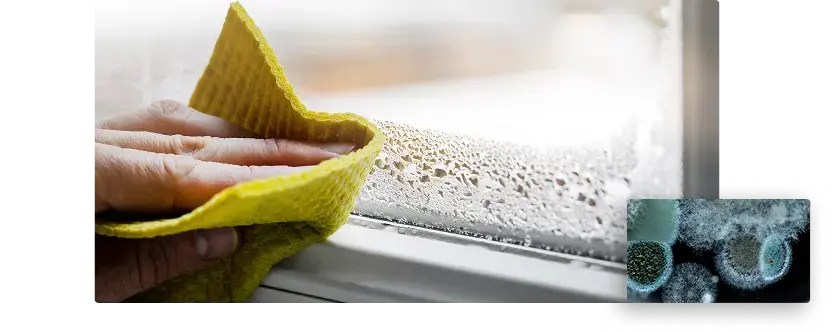
Dirt buildup in fans or unbalanced components can cause an MVHR unit to become noisy, disrupting a home’s acoustic quality. Maintenance ensures correct operation by addressing these issues and minimising noise levels.
Like any mechanical system, regularly servicing and cleaning an MVHR unit keeps its components in good working order. This routine care extends the system’s overall lifespan, protecting your investment for years to come.
Building regulations require efficient ventilation system maintenance to ensure safety and performance standards are met. Keeping MVHR systems in healthy condition helps you remain compliant and avoid penalties.
MVHR systems play a vital role in managing indoor humidity levels. Blocked filters or ducts can trap moisture, creating the perfect conditions for mould growth inside the system or living space.
 What to look for:
What to look for:Look for a partner that offers comprehensive aftercare services, including filter replacements, maintenance training, and responsive technical support. A partner who prioritises post-handover services demonstrates their commitment to building long-term relationships and ensuring the success of your project well into its operational phase.
Maintenance checklist for MVHR units*
| Maintenance task | Frequency | Details | Materials/tools required |
|
Replace filters |
Every 12 months/more frequently in polluted or high-usage areas. |
Replace filters as per the manufacturer’s recommendations. |
Replacement filters (manufacturer-approved), soft cloth, and gloves. |
|
Clean ductwork |
Every 1–3 years |
Inspect and clean ducts to remove dust and debris, ensuring no blockages in airflow. |
Vacuum cleaner with hose attachment, duct brushes, and protective mask. |
|
Check heat exchanger |
Annually |
Inspect for dust and debris; gently clean using a soft brush or air blower to avoid damaging components. |
Soft brush, air blower, lint-free cloth. |
|
Inspect fans and motors |
Annually or as needed |
Ensure fans and motors are dirt-free, spinning smoothly, and operating correctly. |
Screwdriver, soft brush, and cleaning spray suitable for electronics. |
|
Test airflows |
Annually or after maintenance |
Balance the system using airflow measurement tools to ensure proper supply and extraction rates. |
Airflow meter, manometer, and calibration tools. |
|
Check drainage system |
Every 6 months |
Clear blockages from condensate drains to prevent water buildup and ensure proper drainage. |
Flexible cleaning wire, mild detergent, gloves, bucket. |
*A professional, ventilation specialist or maintenance company should be contacted for maintenance requirements. Titon does not assume liability for any maintenance-related activity carried out on Titon products.
Support for different ventilation system types
Choosing the right ventilation system is essential for ensuring optimal indoor air quality, energy efficiency, and compliance with building regulations. Different systems suit different building types and environmental goals, so having the guidance of an experienced partner can make all the difference.
Below is an overview of four key system types: Mechanical Ventilation with Heat Recovery (MVHR), centralised Continuous Mechanical Extract Ventilation (MEV), decentralised Continuous Mechanical Extract Ventilation (dMEV), and Natural ventilation with background ventilators & intermittent extract fans.

Mechanical Ventilation with Heat Recovery (MVHR)
MVHR systems provide continuous fresh air while recovering heat from extracted air to warm incoming air, reducing heating demand. These systems are ideal for modern, airtight buildings where energy efficiency is a priority. By managing humidity levels and filtering out pollutants, MVHR also supports healthier living environments.
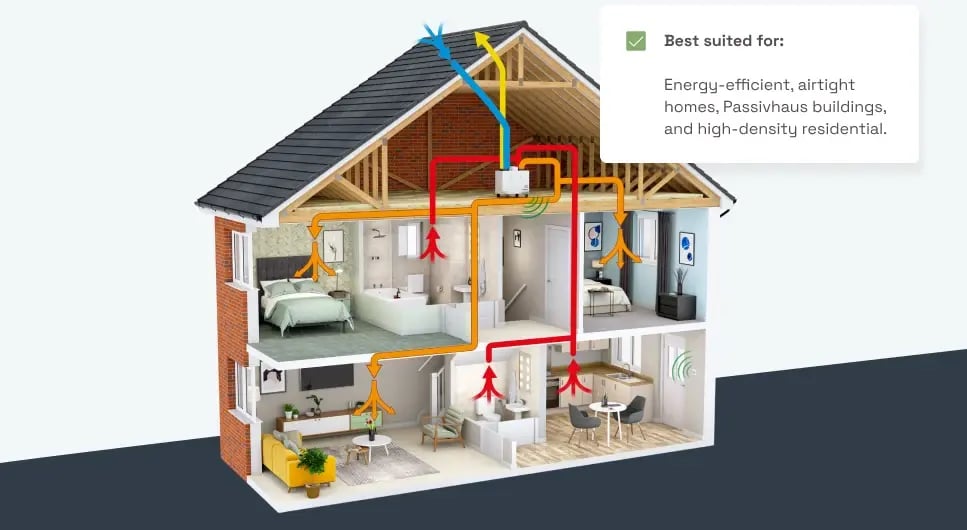
Advantages
- Controlled airflows.
- Pre-heated incoming fresh air.
- Heat exchange may reduce heat demand.
- May be useful where external noise pollution is a problem, as there are fewer building penetrations.
- Improved indoor air quality with filtered fresh air.
- Excellent for residential units aiming for sustainability goals.
Considerations
- Accommodating the fan unit and concealing all ducts.
- Perceived high running costs, though usually not actual.
- For the system to be effective, the dwelling needs to have an airtightness of less than 0.2 air changes per hour.
- Noise potential, especially if ducts are poorly installed.
- Needs regular maintenance, including filter changes and heat exchanger cleaning.
Centralised Continuous Mechanical Extract Ventilation (MEV)
MEV systems extract stale air from wet rooms such as kitchens and bathrooms, ensuring continuous airflow throughout the building. They are simpler than MVHR systems but still offer reliable air quality improvements.
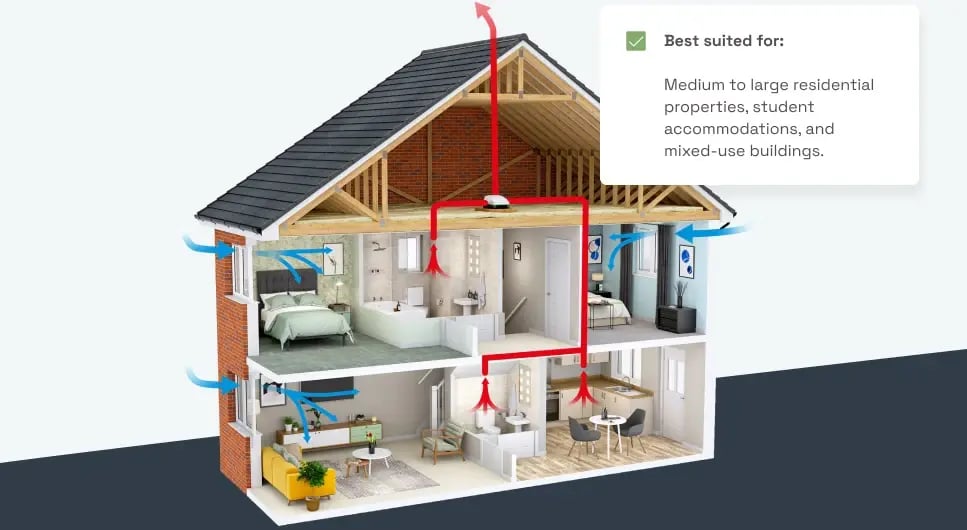
Advantages
- Continuous ventilation at predetermined rates.
- Low noise.
- Discreet.
- Single penetration to external building fabric.
- Lower installation cost compared to MVHR.
- Reduces condensation and moisture buildup.
- Suitable for projects where heat recovery is less critical.
Considerations
- Perceived high running costs, though usually not actual.
- Noise potential, especially if ducts are poorly installed.
- Ductwork may be difficult to conceal.
- Does not recover heat from extracted air, making it less energy-efficient than MVHR.
- Requires careful balancing to ensure even extraction across multiple rooms.
Decentralised Continuous Mechanical Extract Ventilation (dMEV)
DMEV units provide continuous extraction from wet rooms such as kitchens and bathrooms. These units are installed directly through external walls, avoiding the need for extensive ducting systems. They operate at low noise levels and can significantly improve indoor air quality by reducing moisture, preventing mould growth, and removing pollutants.
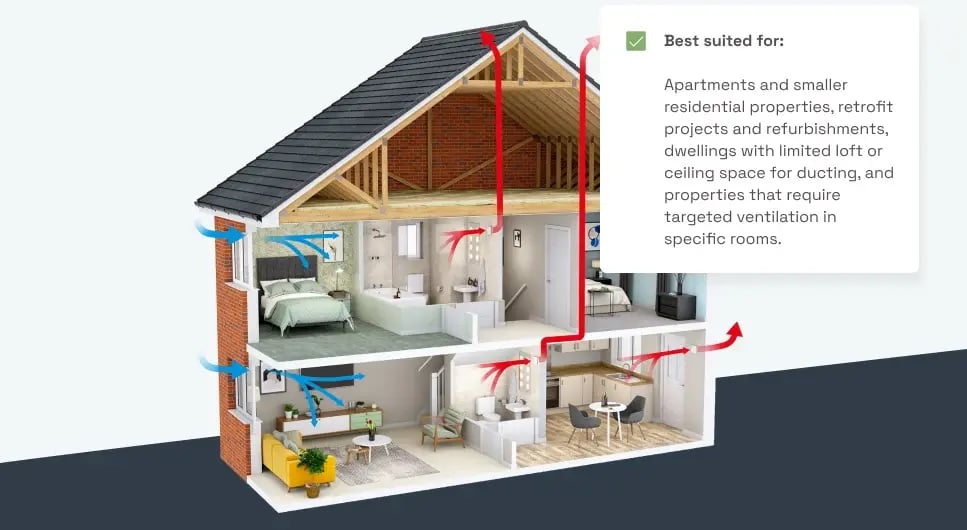
Advantages
- Simple to install – minimal ductwork required.
- Quiet operation, enhancing occupant comfort.
- Energy efficient with low power consumption.
- Prevents localised condensation and mould growth.
- Suitable for properties where whole-house systems like MEV or MVHR may be impractical.
Considerations
- May require multiple units for larger properties, increasing initial cost.
- Each unit requires an external wall penetration, which may not be ideal for all facades.
- No heat recovery, leading to higher energy loss compared to MVHR systems.
- Requires regular cleaning and maintenance to maintain performance.
- Can be less discreet compared to centralised systems.
Natural ventilation with background ventilators & intermittent extract fans (guidance suitable only for less airtight dwellings)
Extract fans are cost-effective, targeted solutions for removing moisture and odours from specific rooms. They are commonly used in retrofits or as part of a broader ventilation strategy in less airtight buildings.
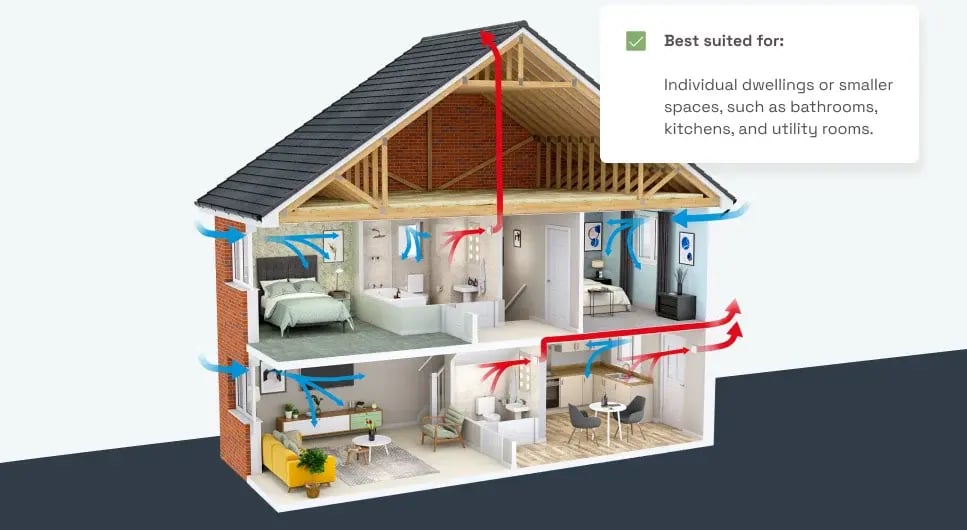
Advantages
- Quick and simple to install.
- Budget-friendly solution for specific ventilation needs.
- Low maintenance requirements.
Considerations
- Limited scope—cannot provide whole-house ventilation.
- Less suitable for highly airtight or energy-efficient buildings.
How a knowledgeable partner adds value
Choosing the right ventilation system requires a thorough understanding of factors like building size, occupancy patterns, airtightness, and energy efficiency goals. A knowledgeable ventilation partner can assess these variables and recommend the most suitable system for your project.
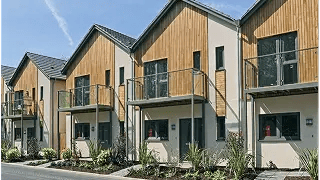
For Multi-dwelling units
MVHR might be the best option to ensure efficiency and compliance with sustainability goals.
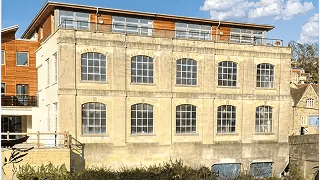
For Retrofits
MEV or extract fans may provide practical and costeffective solutions.

For Bespoke Projects
Partners like Titon can tailor ventilation strategies, providing design support and product specifications to meet unique requirements.
By working with an expert partner, you can confidently select and implement the best ventilation solution for your project, ensuring efficient performance, regulatory compliance, and occupant comfort.

Product microsites and digital resources
Part of providing high-quality documentation is also providing easy access to accurate and detailed product information. Product specific microsites provide a one-stop hub for specifications, installation guides, and technical support materials, streamlining processes for project managers, installers, and aftercare teams. These digital resources, readily available within a few clicks, save time, reduce errors, and ensure the proper implementation of your chosen ventilation solutions.
Why product microsites matter
A well-designed microsite offers immediate access to critical resources, empowering stakeholders at every stage of the project lifecycle. Whether it’s retrieving specs during design, referencing installation manuals on-site, or accessing compliance certificates during inspections, the convenience of a centralised information repository reduces project delays and keeps frustrations to a minimum.
For project managers, product microsites eliminate the need to juggle multiple documents or constantly liaise with suppliers for clarification. All essential details—from product dimensions to performance data— are readily available, making specification, ordering, and compliance tasks far simpler.
For installers, step-by-step installation guides, wiring diagrams, and troubleshooting materials ensure that systems are installed correctly and on time. Digital access means installers can pull up the exact resources they need on-site via a tablet or smartphone right when they need them.
A great example of effective resource microsites is Titon’s Ventilation Systems Resource Centre. It provides a comprehensive collection of tools and information for contractors, specifiers, and building professionals, including:
- Detailed specifications: Clear data sheets and performance summaries for every ventilation product.
- Installation guides: Accessible PDFs and videos to support proper installation practices.
- Compliance certifications: Easy-to-download documents like SAP ratings, CE markings, and regulatory approvals.
- Maintenance tips: Ongoing care instructions to ensure systems remain efficient and durable.
Conclusion: Making the right choice
A successful ventilation strategy is built on more than just high-quality products—it requires the expertise, support, and reliability of a well-rounded ventilation solutions partner. From providing end-to-end solutions, tailored design services, and structured delivery to offering robust commissioning support and accessible digital resources, the right partner simplifies complexities at every stage of your project.
By choosing a partner who prioritises quality, compliance, and customer care, you not only get products that enhance indoor air quality, energy efficiency, and occupant comfort but also gain a trusted ally who lightens the workload, minimises the risks, and ensures your project runs smoothly—saving you time, money, and stress at every turn. By choosing expertise and trust, you can confidently achieve sustainable, regulatory-compliant ventilation outcomes that stand the test of time.
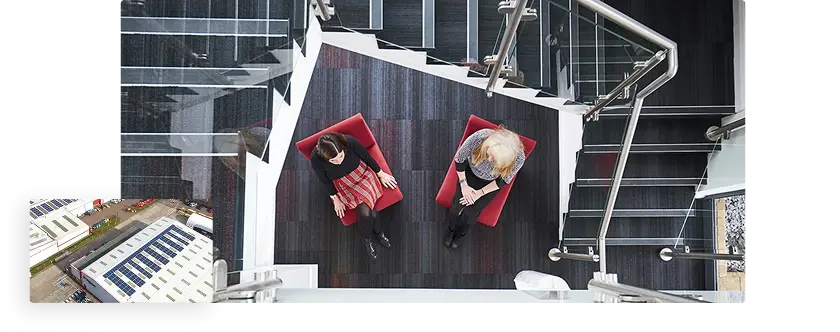
Titon: The indoor air quality experts
At Titon, we believe everyone deserves to breathe cleaner, healthier air. With decades of expertise in designing and manufacturing advanced ventilation solutions, we are passionate about creating systems that improve indoor air quality, enhance comfort, and contribute to healthier living and working environments.
From highly efficient MVHR systems ideal for airtight, energy-efficient homes to MEV solutions and extract fans suited to medium-density buildings or retrofit projects, Titon provides the versatility and performance you need for every development type.
Our commitment to quality and reliability is demonstrated through our ISO and SAP certifications, and we are dedicated to supplier excellence. Combining rigorous product testing with outstanding service ensures that our every solution exceeds expectations.
As a trusted end-to-end partner, we support your project from start to finish. Whether it’s helping you select the right system, providing tailored design advice, coordinating on-site support, or offering maintenance and aftercare resources, we ensure your ventilation systems perform seamlessly at every stage.
